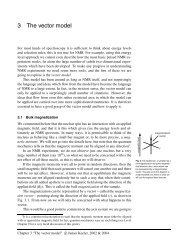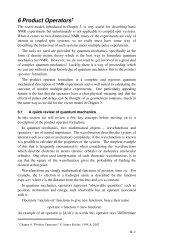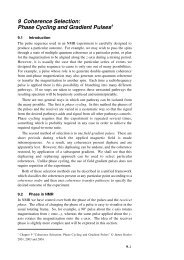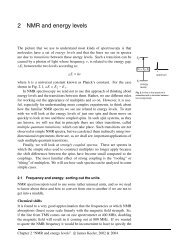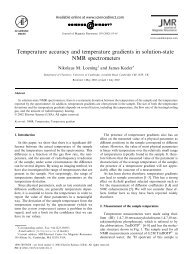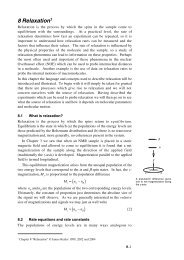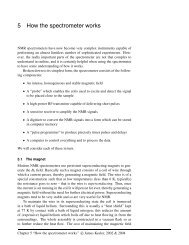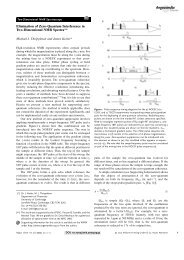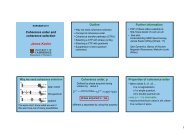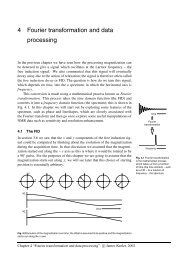Phase Cycling and Gradient Pulses - The James Keeler Group
Phase Cycling and Gradient Pulses - The James Keeler Group
Phase Cycling and Gradient Pulses - The James Keeler Group
You also want an ePaper? Increase the reach of your titles
YUMPU automatically turns print PDFs into web optimized ePapers that Google loves.
As the cycle has four steps, a pathway with ∆p = +2 is also selected; this is<br />
the pathway which starts with p = –1 <strong>and</strong> is transferred to p = +1. <strong>The</strong>refore,<br />
the four steps of EXORCYLE select both of the pathways shown in the diagram<br />
above.<br />
A two step cycle, consisting of 0°, 180° for the 180° pulse <strong>and</strong> 0°, 0° for the<br />
receiver, can easily be shown to select all even values of ∆p. This reduced form<br />
of EXORCYCLE is sometimes used when it is necessary to minimise the<br />
number of steps in a phase cycle. An eight step cycle, in which the 180° pulse<br />
is advanced in steps of 45°, can be used to select the refocusing of doublequantum<br />
coherence in which the transfer is from<br />
p = +2 to –2 (i.e. ∆p = –4) or vice versa.<br />
9.5.4 Combining phase cycles<br />
Suppose that we wish to select the pathway shown opposite; for the first pulse<br />
∆p is 1 <strong>and</strong> for the second it is –2. We can construct a four-step cycle for each<br />
pulse, but to select the overall pathway shown these two cycles have to be<br />
completed independently of one another. This means that there will be a total<br />
of sixteen steps. <strong>The</strong> table shows how the appropriate receiver cycling can be<br />
determined<br />
1<br />
0<br />
–1<br />
Step<br />
phase of 1st<br />
pulse<br />
phase for<br />
∆p = 1<br />
phase of 2nd<br />
pulse<br />
phase for<br />
∆p = –2<br />
total<br />
phase<br />
equivalent phase =<br />
rx. phase<br />
1 0 0 0 0 0 0<br />
2 90 –90 0 0 –90 270<br />
3 180 –180 0 0 –180 180<br />
4 270 –270 0 0 –270 90<br />
5 0 0 90 180 180 180<br />
6 90 –90 90 180 90 90<br />
7 180 –180 90 180 0 0<br />
8 270 –270 90 180 –90 270<br />
9 0 0 180 360 360 0<br />
10 90 –90 180 360 270 270<br />
11 180 –180 180 360 180 180<br />
12 270 –270 180 360 90 90<br />
13 0 0 270 540 540 180<br />
14 90 –90 270 540 450 90<br />
15 180 –180 270 540 360 0<br />
16 270 –270 270 540 270 270<br />
In the first four steps the phase of the second pulse is held constant <strong>and</strong> the<br />
phase of the first pulse simply goes through the four steps 0° 90° 180° 270°. As<br />
we are selecting ∆p = 1 for this pulse, the receiver phases are simply 0°, 270°,<br />
180°, 90°.<br />
Steps 5 to 8 are a repeat of steps 1–4 except that the phase of the second<br />
pulse has been moved by 90°. As ∆p for the second pulse is –2, the required<br />
9–25



